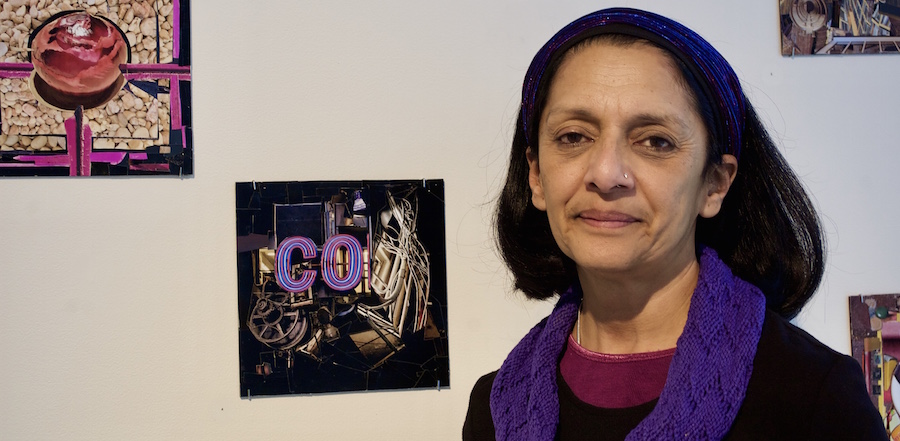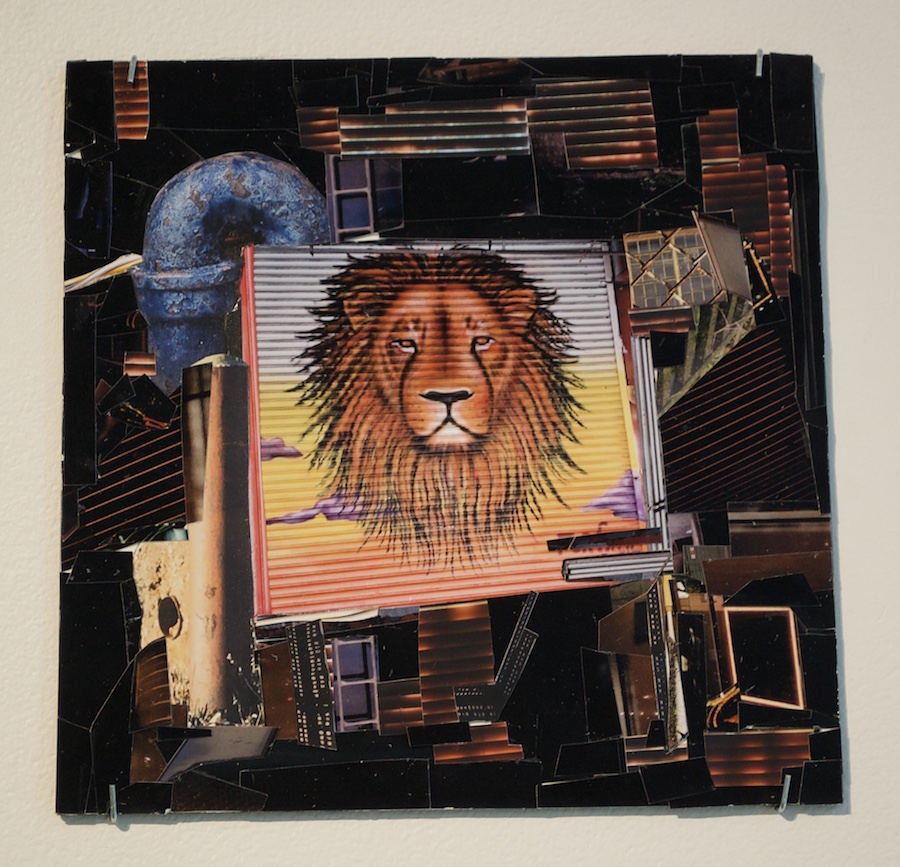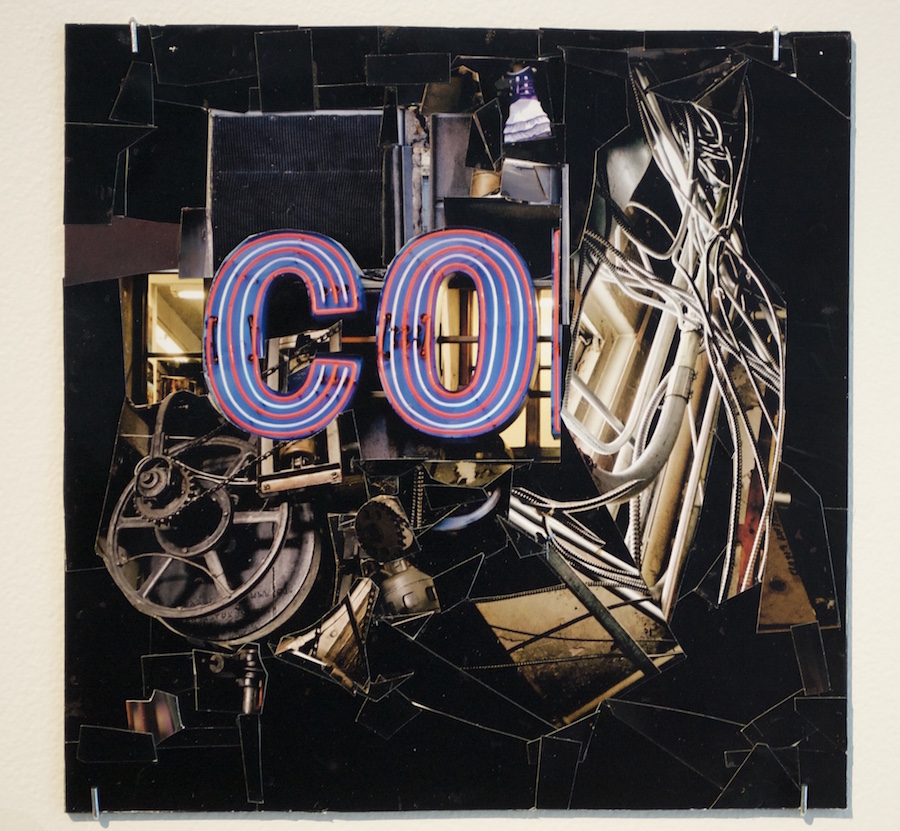
Hartford | Arts & Culture | Visual Arts

| The artist with her work. Kerri Provost Photos. |
A menacing lion stares down anyone approaching the steel security door, guarding his world of detached windows, storefront grills, and a blue chipped and corroded pipe. He offers illumination in this otherwise dark, industrial landscape.
Or, it could be he is merely observing the chaos of urban disintegration in the artist Rashmi Talpade’s photo collage, “Pride.”
The lion is part of Urban Legends of Modern Archeology, Talpade’s most recent exhibition at the main branch of the Hartford Public Library. After opening Friday evening in the library’s Artwalk Gallery, the show runs through Feb. 24. The artist is scheduled to give a talk on the work at Feb. 9. Hours and more information are available at the library’s website.
The exhibition is presented as “an archaeological dig, with no hierarchy given to the images.” Each collage is eight by eight inches, encouraging a “closer and more intimate” experience for the viewer. Talpade, who goes publicly by her first name and generally works in a larger collage format, said that moving to smaller-scale piece was a challenge.

Rashmi spent two years working on this series in her Wallingford studio. Building it, she went with an old-school collage format—no photoshop, just cutting and pasting images that she had taken from different urban environments.
But the inspiration goes back to her childhood in Mumbai, where crows are the only animals she recalls seeing. Now, she said, “the urban aspect of the world is always” in her work. The photographs in Urban Legends were taken “all over,” including New Haven and India. Objects ubiquitous within the urban landscape make appearances in these square collages, from fire hydrants to hubcaps to benches.
That’s apparent in “Funeral,” which consists of two red-throated birds resting on rolled sheets of plastic trash to resemble a satin casket pillow. Asphalt crumbles above them, precariously supporting a building with floor-to-ceiling windows. The world of this collage threatens to collapse, taking more victims than the birds that had already succumbed to its windows.
Rashmi sees a tension between the natural world and that of ever-evolving technology. Detritus may go unnoticed by casual observers of urban spaces; animal carcasses and urban remnants like busted windows can be passed over. Photography and collage is a way for Rashmi to give the dead birds recognition, and they are the subject of multiple creations in this exhibit.

“Monoxide,” like “Pride,” draws the viewer with the pink-and-blue glow of a neon sign that seems to command “GO” from a distance. Neutral tones create the backdrop: bicycle chains, windows, a mid-range white fluorescent light. Only up close does its message—the letters “CO”—become apparent, showing the ease with which misreading an environment is possible. Still, those glowing letters may have been selected from a larger word, taken out of context to create a sinister new one.
Rashmi said she classifies this work as an “exploration of the time we’re in,” but added that others’ interpretation of the work is up to them, as everyone’s experiences shape their perspectives. To assist viewers, she assigns short one- or two-word titles to her pieces. If there were no logistical need, she would leave each untitled. Positive or negative, she said she wants “the piece to make some kind of difference to a viewer,” to make them think.
It’s no surprise, then, that she draws inspiration from those who have made strong, unapologetic artistic contributions. Among them are Georgia O’Keefe, who Rashmi describes as “unrestrained” and not concerned with others’ opinions of her. Cindy Sherman, who has “no boundaries” is another influence.
Each item in Urban Legends feels carefully considered, with attention to texture and color. Even when the thematic link between a watchful lion and a street in disrepair is unclear, the visual presentation stirs curiosity.
Rashmi’s next move is to work on an “industrial wastescapes” series, building off her focus on “grunge,” something she “find[s] beautiful, sort of.” While much of her work may reflect global decline, she added that “I refuse to be sad about a lot of the things I photograph.”
She will also be leading a community art project in the Essex school system, hoping to engage both the elementary students and their parents. That background has also come to the Artwalk Gallery: on the gallery’s south and east walls are several works resulting from previous community art projects at Yale New Haven Children’s Hospital and branches of the New Haven Free Public Library (NHFPL).
During those projects, participants simply walked in, something she said was made possible by the accessibility of collage, a form almost everyone has practiced. The results have been displayed in the New Haven libraries where participants can view their own art.
Rashmi Talpade’s Urban Legends of Modern Archeology runs at the Hartford Public Library’s Artwalk Gallery through Sunday, Feb. 24. Hours are Monday through Thursday, 9:30 a.m.–8:00 p.m.; Friday and Saturday, 9:30 a.m.– 5:00 p.m.; Sunday, 1:00-5:00 p.m.

